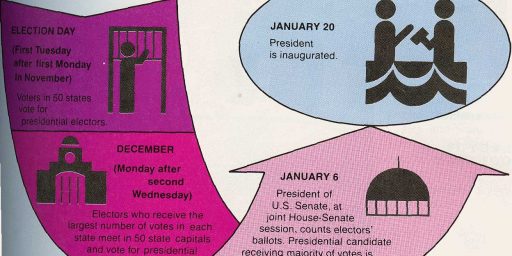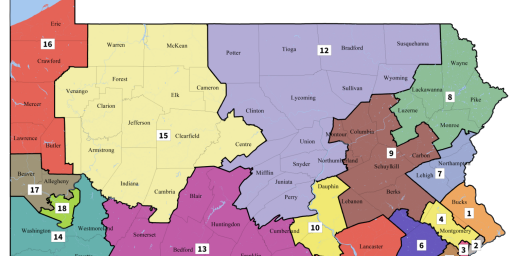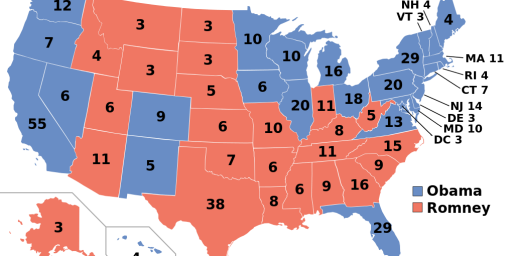THIRD PARTIES
Alex Knapp, responding to yesterday’s Day by Day cartoon, observes,
If there’s one thing that Republicans and Democrats can and do agree on, it’s outrageous election rules that make any viable third party practically impossible.
This presumes a demand for a third party, which I see little evidence of. Further, while the dominant parties have rigged some of the rules to favor themselves, those obstacles are quite minor and could easily be overcome by any organization popular enough to become viable in the first place.
The main structural reason for a two-party system was put in place by the Framers before the advent of political parties in the U.S.: a single member district electoral system. Since Congressional districts are winner-take-all, political parties or candidates who appeal to a narrow ideological segment aren’t going to fare too well. There’s no prize for second place. Thus, with SMD, as night follows day, comes catch-all parties: moderate, bland parties that can appeal to something close to a majority. The alternative is some version of proportional representation, but that is often chaotic and has weird consequences of its own. In PR, it’s often the case that the tail wags the dog: a fringe party gains disproportionate control because it’s the key to a coalition government.
The US Senate was initially an appointed office, although it, too, was at-large and thus had to gain a consensus in the state legislature. It’s been an elective office since 1912 and, again, SMD.
The presidency, as we saw so clearly in 2000, is elected in similar fashion: 48 of the 50 states plus the District of Columbia award all their electoral votes to the candidate who garners the most votes statewide. (Maine and Nebraska both grant two votes to the statewide winner and one to the winner in each of the Congressional Districts). Third party candidates have won state electoral delegations as recently as 1968. But, again, the down side is exemplified by Ralph Nader, who was strong enough a candidate to garner a substantial number of votes but not nearly enough to win a single state. But his running split vote of the center-left coalition enough in a close race to cost Gore the election.
A candidate who isn’t a Democrat or a Republican can win in any of these races, but they have to capture the public imagination. See Jesse Ventura or even Lowell Weicker. There were no structural barriers to Ross Perot winning the presidency in 1992; he simply alienated too much of the electorate to have a chance. And, once a candidate starts to fall, the pressure to not “waste your vote” comes into play, as we now see in the California recall contest.






Having sat on the state committee of a Libertarian Party, let me assure you that there are some significant barriers to third parties. First is ballot access. The rules as they’re set up make it very difficult to get on the ballot as a third party (as opposed to an independent.) Campaign finance laws force a lot of paperwork that represents a drop in the bucket in terms of costs for the big parties but can be enormously expensive to parties trying to gain more support. They also have the dual side effect of limiting contributions from big donors–a problem exacerbated by the new ban on soft money. And this is just the beginning. There are lots of legal, structural barriers to third parties, and compounded with the general society’s view of “throwing your vote away”–encouraged by the big parties–that make it hard for any third party to get off the ground.
Alex,
I don’t disagree that the rules for ballot access and campaign finance are an additional obstacle. But they’re comparatively small to those of interest and popularity. While I’m probably more aligned with the Libertarian Party platform on most issues than the Republicans’, I recognize that that puts me in a tiny, tiny, tiny minority. And, frankly, I’m not sure I’ve ever encountered a Libertarian Party candidate who wasn’t a complete, blithering idiot.
A small point granted, but the senate has never been made up of appointed officers. Prior to the election by the general population, the election was made by the varied state legislatures. This was an indirect election by the general population in as much as the party that won the legislative races would generally elect senators from their own party. That is why the Lincoln-Douglas debates figure so prominently in American lore.
Leroy.
Right. But, by that standard, all offices are “elected.” The Supreme Court is, for example, nominated by an elected president, who appoints members of his political persuasion, with checks by an elected Senate. But it’s not quite the same dynamic as an elected office.
James, I’m glad there are people who understand why the two party system is a GOOD thing. All you have to do is look at all the other countries that let third and fourth and fifth parties into the governing body it’s obvious that we’re better off.
The key is winner takes all. Most parliamentary systems give power to parties with less than 10 percent of the vote. But it takes a majority to pass a law. Thus you end up with green party crazies controlling the debate because there isn’t a large enough moderate coalition to push it through.
In our system, moderates dominate because you pretty much need majorities to win. But that doesn’t mean that there’s no breadth of policy. Within the Republican party there are Tom Delays and Dubyas and Ahnolds and Jumpin Jims.
—